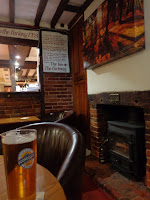This post is about my trip to Oktoberfest (top), which clearly shows how behind I am on writing my blog. But it's even worse than you think because Oktoberfest is actually in September -- and I went to Munich for the very first weekend of the festival. Here's something else you might not have known (I didn't, at least): Oktoberfest is basically a big state fair but with more beer and lederhosen. The festival takes places on the Theresienwiese, which becomes a fairground full of thrill rides and food vendors (bottom left) whose multiple midways are packed with partiers day and night (bottom right).
But if you want to experience the full spectrum of fun, you need to show up early. We were in line by 9 a.m., so we could be one of the first through the door to the Augustiner-Festzelt. We snagged a bench shortly after 10 a.m., but no booze was on offer until after the Procession of Officials (top left), which preceded the ceremonial tapping of the first keg at noon (top right). After the brewer ensured the suitability of the suds, the bar staff started filling mugs as fast as humanly possible (bottom).Eventually, a glass the size of my head appeared in front of me (top left). Luckily, I had padded my stomach with a pretzel the size of my head as well (top right), so I was fortified for the merriment ahead. The celebration mainly consists of overcoming language barriers with your tablemates. The conversation often is interrupted by the band playing the "Ein Prosit" song, which provokes a collective raising of glasses (bottom left). Occasionally, we climbed on the benches to sing and dance, and sometimes, a brave soul would stand astride a table in an attempt to chug his whole glass before bouncers escorted him (or her) out of the tent. But the best entertainment simply comes from people watching, especially their mating rituals. I found the skills of the group of Dutch gentlemen across the aisle to be particularly on point (bottom right); I mean, who can resist matching green-checkered shirts, right?
Each beer tent has its own reputation; ours was hailed as cozy and friendly. We also chose ours because it was promoted as a classic: Munich's oldest brewery pouring drinks out of traditional wooden kegs. But clearly, we wanted to do some comparison, so we stopped by some other tents. One that shall not be named struck me as the smelly and sullied remnants of a frat party. On our second day, we tried the Paulaner-Festzelt, which seemed to have a more local feel (left). A brass band from an earlier parade played impromptu versions of "Ein Prosit" when the main tent band was on break (right).
Even in a short weekend getaway, you can only do so much beer drinking -- at least at my age. So we did take a break for some sightseeing. During a stroll through downtown Munich, we peeked in St. Michael's Kirche (top left) on our way to the main square, Marienplatz. We arrived at the Neues Rathaus (top right) just in time to catch the Glockenspiel display one of its limited daily whirls (bottom).
Back on the bigger, more modern streets, we stopped to watch the Traditional Costume Parade pass by. Each Oktoberfest brewer submits an entry; most consisted of horse-drawn barrel wagons (top left), but some opted for hop-pole floats (top right). The clothing on display was a bit more diverse, ranging from the hunting gear of the countryside (bottom left) to the fancier frocks of the more citified (bottom right).
We had a pretty good view of the parade, but some locals found a prime perch from which to observe the procession (left). Seeing these residents and a mobile maypole (right) -- from the further files of things I didn't know, May 1 is Maypole, or Maibaum, Day, and around that time Munich hosts Frühlingsfest, which is affectionately known as "Little Oktoberfest" -- were good reminders that, ultimately, this world-famous festival is really still a community celebration.
To wit, held adjacent to the booze carnival is the Bayerisches Zentral-Landwirtschaftsfest, an agricultural exhibition nearly identical to a state fair. There, you can buy tractors and playgrounds for your goats (top left). You can also check out which livestock won awards (top right) and sample käsespaetzle made from the milk of said livestock (bottom left). We had the common decency, however, to eat the obligatory wiener schnitzel meal away from its maternal makers, at Wirsthaus im Braunauer-Hof (bottom right).
























































